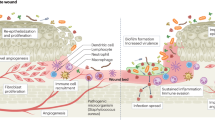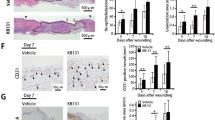Abstract
Antibiotic treatment eliminates commensal bacteria and impairs mucosal innate immune defenses in the gut. However, whether oral antibiotic treatment could alter the composition of the microbiota on the skin surface and influence innate immune responses remains unclear. To test this, mice were treated with vancomycin for 7 days and then wounds were made on the back skin of the mice. Five days later, scar tissue from each mouse was collected for bacterial enumeration, the bacterial composition on the scar and unwounded skin was determined using 16S RNA gene-based pyrosequencing analysis, and skin around wounds was collected for RNA extraction. Compared with the control group, the overall density and composition of skin bacteria were altered, and the proportion of Staphylococcus-related sequences was reduced in the vancomycin-treated group. Moreover, vancomycin treatment decreased the expression of RegIIIγ and interleukin (IL)-17 in the wounded skin. Taken together, our data demonstrate that antibiotic treatment decreases the bacterial density and alters the bacterial composition in skin wounds, followed by a decrease in RegIIIγ expression, which may contribute to the delayed wound repair. Our findings also indicate that antibiotic therapy should be carefully considered in the treatment of skin injury.



Similar content being viewed by others
References
Brandl K, Plitas G, Mihu CN, Ubeda C, Jia T, Fleisher M, Schnabl B, DeMatteo RP, Pamer EG (2008) Vancomycin-resistant enterococci exploit antibiotic-induced innate immune deficits. Nature 455(7214):804–807
Carles U, Ying T, Robet RJ, Michele JE, Tammy S, Miriam S, Agnes V, Nicholas DS, Marcel RMB, Mini K, Eric GP (2010) Vancomycin-resistant Enterococcus domination of intestinal microbiota is enabled by antibiotic treatment in mice and precedes bloodstream invasion in humans. J Clin Invest 120(12):4332–4341
Hill DA, Hoffmann C, Abt MC, Du Y, Kobuley D, Kirn TJ, Bushman FD, Artis D (2010) Metagenomic analyses reveal antibiotic-induced temporal and spatial changes in intestinal microbiota with associated alterations in immune cell homeostasis. Mucosal Immunol 3(2):148–158
Martin P (1997) Wound healing–aiming for perfect skin regeneration. Science 276(5309):75–81
Finnerty CC, Przkora R, Herndon DN, Jeschke MG (2009) Cytokine expression profile over time in burned mice. Cytokine 45(1):20–25. doi:10.1016/j.cyto.2008.10.005
Lai Y, Di Nardo A, Nakatsuji T, Leichtle A, Yang Y, Cogen AL, Wu ZR, Hooper LV, Schmidt RR, von Aulock S, Radek KA, Huang CM, Ryan AF, Gallo RL (2009) Commensal bacteria regulate Toll-like receptor 3-dependent inflammation after skin injury. Nat Med 15(12):1377–1382. doi:10.1038/nm.2062
Lai Y, Li D, Li C, Muehleisen B, Radek KA, Park HJ, Jiang Z, Li Z, Lei H, Quan Y, Zhang T, Wu Y, Kotol P, Morizane S, Hata TR, Iwatsuki K, Tang C, Gallo RL (2012) The antimicrobial protein REG3A regulates keratinocyte proliferation and differentiation after skin injury. Immunity 37(1):74–84. doi:10.1016/j.immuni.2012.04.010
Sommer K, Sander AL, Albig M, Weber R, Henrich D, Frank J, Marzi I, Jakob H (2013) Delayed wound repair in sepsis is associated with reduced local pro-inflammatory cytokine expression. PLoS One 8(9):e73992. doi:10.1371/journal.pone.0073992
Gallo RL, Nakatsuji T (2011) Microbial symbiosis with the innate immune defense system of the skin. J Invest Dermatol 131(10):1974–1980
Kong HH, Oh J, Deming C, Conlan S, Grice EA, Beatson MA, Nomicos E, Polley EC, Komarow HD, Murray PR, Turner ML, Segre JA (2012) Temporal shifts in the skin microbiome associated with disease flares and treatment in children with atopic dermatitis. Genome Res 22(5):850–859
Grice EA, Segre JA (2011) The skin microbiome. Nat Rev Microbiol 9(4):244–253
Gao Z, Tseng CH, Pei Z, Blaser MJ (2007) Molecular analysis of human forearm superficial skin bacterial biota. Proc Natl Acad Sci U S A 104(8):2927–2932
Grice EA, Kong HH, Conlan S, Deming CB, Davis J, Young AC, Bouffard GG, Blakesley RW, Murray PR, Green ED, Turner ML, Segre JA (2009) Topographical and temporal diversity of the human skin microbiome. Science 324(5931):1190–1192
Costello EK, Lauber CL, Hamady M, Fierer N, Gordon JI, Knight R (2009) Bacterial community variation in human body habitats across space and time. Science 326(5960):1694–1697
Garcia-Garcera M, Coscolla M, Garcia-Etxebarria K, Martin-Caballero J, Gonzalez-Candelas F, Latorre A, Calafell F (2012) Staphylococcus prevails in the skin microbiota of long-term immunodeficient mice. Environ Microbiol 14(8):2087–2098. doi:10.1111/j.1462-2920.2012.02756.x
Lai Y, Cogen AL, Radek KA, Park HJ, Macleod DT, Leichtle A, Ryan AF, Di Nardo A, Gallo RL (2010) Activation of TLR2 by a small molecule produced by Staphylococcus epidermidis increases antimicrobial defense against bacterial skin infections. J Invest Dermatol 130(9):2211–2221
Li D, Lei H, Li Z, Li H, Wang Y, Lai Y (2013) A novel lipopeptide from skin commensal activates TLR2/CD36-p38 MAPK signaling to increase antibacterial defense against bacterial infection. PLoS One 8(3):e58288. doi:10.1371/journal.pone.0058288
Naik S, Bouladoux N, Wilhelm C, Molloy MJ, Salcedo R, Kastenmuller W, Deming C, Quinones M, Koo L, Conlan S, Spencer S, Hall JA, Dzutsev A, Kong H, Campbell DJ, Trinchieri G, Segre JA, Belkaid Y (2012) Compartmentalized control of skin immunity by resident commensals. Science 337(6098):1115–1119. doi:10.1126/science.1225152
Blaser MJ (2006) Who are we? Indigenous microbes and the ecology of human diseases. EMBO Rep 7(10):956–960
Cash HL, Whitham CV, Behrendt CL, Hooper LV (2006) Symbiotic bacteria direct expression of an intestinal bactericidal lectin. Science 313(5790):1126–1130. doi:10.1126/science.1127119
Kinnebrew MA, Ubeda C, Zenewicz LA, Smith N, Flavell RA, Pamer EG (2010) Bacterial flagellin stimulates Toll-like receptor 5-dependent defense against vancomycin-resistant Enterococcus infection. J Infect Dis 201(4):534–543
Huse SM, Huber JA, Morrison HG, Sogin ML, Welch DM (2007) Accuracy and quality of massively parallel DNA pyrosequencing. Genome Biol 8(7):R143
Dixon P (2009) Vegan, a package of R functions for community ecology. J Veg Sci. doi:10.1111/j.1654-1103.2003.tb02228.x
Pierre EJ, Perez-Polo JR, Mitchell AT, Matin S, Foyt HL, Herndon DN (1997) Insulin-like growth factor-I liposomal gene transfer and systemic growth hormone stimulate wound healing. J Burn Care Rehabil 18(4):287–291
Whitehead J (2009) Intestinal alkaline phosphatase: the molecular link between rosacea and gastrointestinal disease? Med Hypotheses 73(6):1019–1022. doi:10.1016/j.mehy.2009.02.049
Price LB, Liu CM, Melendez JH, Frankel YM, Engelthaler D, Aziz M, Bowers J, Rattray R, Ravel J, Kingsley C, Keim PS, Lazarus GS, Zenilman JM (2009) Community analysis of chronic wound bacteria using 16S rRNA gene-based pyrosequencing: impact of diabetes and antibiotics on chronic wound microbiota. PLoS One 4(7):e6462
Zhang CH, Zhang MH, Wang SY, Han RJ, Cao YF, Hua WY, Mao YJ, Zhang XJ, Pang XY, Wei HC, Zhao GP, Chen Y, Zhao LP (2010) Interactions between gut microbiota, host genetics and diet relevant to development of metabolic syndromes in mice. ISME J 4:232–241
Zhang MLZM, Zhang CH, Du HM, Wei GF, Pang XY, Zhou HK, Liu BB, Zhao LP (2009) Pattern extraction of structural responses of gut microbiota to rotavirus infection via multivariate statistical analysis of clone library data. FEMS Microbiol Ecol 70:177–185
Acknowledgments
This work was supported by the National Natural Foundation of China grants (NSFC) (31200683, 31100109, and 81072422, and 11ZR1409900 and 11QA1401900) and the Science and Technology Commission of Shanghai Municipality (11DZ2260300). We thank Lauren Christine Radlinski from the University of Illinois at Urbana-Champaign for proofreading the manuscript.
Conflict of Interest
The authors have no conflict of interest to declare.
Author information
Authors and Affiliations
Corresponding author
Electronic supplementary material
Below is the link to the electronic supplementary material.
ESM 1
(DOC 401 kb)
Rights and permissions
About this article
Cite this article
Zhang, M., Jiang, Z., Li, D. et al. Oral Antibiotic Treatment Induces Skin Microbiota Dysbiosis and Influences Wound Healing. Microb Ecol 69, 415–421 (2015). https://doi.org/10.1007/s00248-014-0504-4
Received:
Accepted:
Published:
Issue Date:
DOI: https://doi.org/10.1007/s00248-014-0504-4




